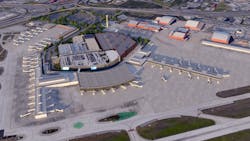Available Funding for Airport Modernization Projects Exceeds $1T
America’s airports are some of the country’s most powerful economic engines. They contribute more than $14 trillion in economic activity annually and support approximately 11.5 million jobs.
Congress, after years of underfunding airport infrastructure projects, recently allocated billions of dollars for upgrades and modernization initiatives. State legislators approved millions more for airport projects, and numerous local governmental entities passed bonds to address critical airport needs. Now that funding is available, an abundance of upcoming opportunities will soon be announced. A few examples follow.
The San Antonio International Airport plans to build a third terminal for an estimated $2.5 billion. The concept design outlines how traffic growth will be managed over the next several years. Immediate projects will include construction of the terminal that will feature up to 17 additional gates, and an extension of the airport’s existing runway. Work will include construction of a ground transportation center, a new parking garage, and terminal road realignments.
Earlier this year, Hawaii’s Department of Transportation completed the sale of airport system revenue bonds. The $230 million in proceeds will fund essential airport modernization projects. Design work is underway for projects to improve and enhance hold rooms for several gates in the main terminal. The funding will include installing additional seating, expanding queue spaces, improving climate control measures, enhancing flight information displays, implementing more responsive fire alarm systems, renovating bathrooms, and installing more efficient lighting. Construction could begin as soon as 2024.
A total of $1.4 billion in construction and renovation projects is available for the modernization of Nashville International Airport. Over multiple phases, the modernization plan includes projects to extend two concourses, construct additional gates, install new moving walkways, and add concessions options. A new air freight facility will be constructed to offer more effective support for airline cargo operations. The plan features an upgraded, more precise, and enhanced secure baggage handling system. Detailed design work is scheduled to begin in August. An early timeline for the plan indicates that construction will begin with extension of Concourse D in late 2023.
Southwest Florida International Airport, located between Tampa and Miami, will modernize its central terminal for greater operational efficiency and improved passenger experience. Earlier this summer, the Lee County Port Authority initiated design work for a new concourse, which is expected to cost $331 million. The project will be the second-largest public works initiative in Lee County’s history. It will consolidate three security checkpoints and leverage technology improvements to streamline passenger processing. Preliminary plans include construction of new vehicle lanes for departing and arriving passengers, modernized airline ticket counters, new restrooms, and expanded aircraft parking. An early, tentative construction timeline suggests that work could wrap up as early as 2025 or as late as 2027.
The nearby Miami International Airport (MIA) also will modernize its facilities to accommodate a recent uptick in passenger traffic. In particular, the airport’s $85.9 million modernization project will address recent strain on its overall parking capacity with construction of a new parking garage. Design work is underway on the project that will soon lead to 1,861 new parking spaces, 16 “pay-on-foot” systems in centralized locations throughout MIA parking facilities, and several “find-my-car” locator systems. Construction is scheduled to begin in March 2023 and finish by July 2025.
The Des Moines Airport Authority is developing a multi-phase plan to modernize the Des Moines International Airport (DSM), the first of which is expected to cost $448.1 million. The airport has already exceeded its long-term passenger forecast, and it has become especially congested under the weight of recent population growth. According to the Authority, DSM needs 17 new gates by 2032 to meet the next wave of airport traffic forecasts. That need has inspired the plan to modernize the airport with an entirely new terminal.
Several modernization projects are underway to ensure that the Billings International Airport (BIL) in Montana can sustain its increasing volume of passengers. The largest project will be to construct a new parking structure at the airport with designated space for car rental companies and a section for public parking. The $25 million project is scheduled for construction in 2024. A smaller $4.5 million project to modernize its cargo facilities with construction of an expanded cargo ramp is set for 2023.
Officials in New Jersey’s Mercer County are guiding efforts to modernize the Trenton-Mercer Airport. The airport’s plan includes an expanded main terminal, approximately five times the current size, to increase the facility’s total number of inbound and outbound flights. Modernization efforts will include four new passenger aircraft parking spaces, new hold room facilities, terminal apron improvements, 10 new ticket counters, three security screening lanes, expanded baggage claim facilities, and new concession options. Mercer County officials anticipate that the project, which is in the design phase, will proceed to the construction phase in 2023. An environmental assessment from earlier this year estimated that the project could cost between $109 million and $163 million.
Airport construction projects will be abundant for the next several years, and contracting opportunities are immediately available in almost every state in the country.
Mary Scott Nabers is president and CEO of Strategic Partnerships Inc., a business development company specializing in government contracting and procurement consulting throughout the U.S. Her recently released book, Inside the Infrastructure Revolution: A Roadmap for Building America, is a handbook for contractors, investors and the public at large seeking to explore how public-private partnerships or joint ventures can help finance their infrastructure projects.
About the Author

